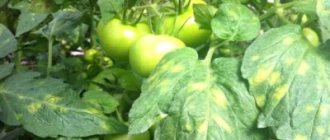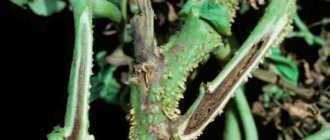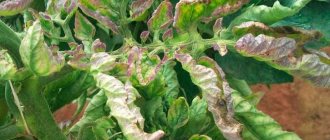Signs of worm damage to tomatoes
To determine whether tomatoes are wormy or not, examine them carefully. Pay special attention to the cutting, since it is through it that pests most often penetrate into the fruit. If there are worms inside the tomato, you will find small holes that look like tunnels.
Some insects feed on the stem of the plant. In this case, tissue damage can be seen, and ovaries and flowers may fall off.
If the roots are damaged, the plant begins to wither and dry out. It is difficult to recognize the true cause of its death - upon examination, it may seem that the tomato lacked moisture or fertilizer.
What kind of worms can there be?
It is impossible to detect pests during the day; their activity phase falls at night. Pests prefer green fruits, but some species feed on roots and stems.
Types of pests:
- scoop;
- click beetle larva or wireworm;
- May beetle larva or beetle;
- root-knot nematode.
How to recognize
Cutworm caterpillars infect the above-ground part of the tomato plant. Adults resemble large gray-brown moths with patterns on their wings. The caterpillars are brown, greenish, and black in color. The insect begins to act in the spring, laying eggs on stems, leaves and ovaries. In one season, 3-4 generations of pests can grow.
Some cutworm species feed on stems, leaves and ovaries, while others prefer fruits. They gnaw a hole in the tomato through which they penetrate and completely eat the pulp.
The larvae of the click beetle are called wireworms because of their external resemblance to wire. The size of the individual is 10-30 mm, the body is oblong with a yellow color. The pest attacks the root system, but sometimes its target is stems with fruits. Factors that provoke its appearance are increased soil humidity and acidity.
May beetle larvae are white in color and look like thick caterpillars with a light orange head. The larvae feed exclusively on roots, causing the plant to die.
The root-knot nematode is a round worm 1 mm long. It lives in the roots of the plant, which is why thickenings appear on them, similar to tubers. As a result, the plant begins to lag behind in development, withers and dries out.
A novice gardener may believe that the death of the plant was due to a lack of minerals, moisture and fertilizers. The pest can be detected only by digging up the bush and examining the root system.
Reference . In Russia, tomatoes are most often affected by the cotton bollworm.
Holes in tomato fruits
Holes in tomatoes are a familiar phenomenon to many gardeners. These are the first signs that a caterpillar has feasted on them. Such a fruit has an unattractive appearance, and its taste is reduced, provided that it has time to ripen. The caterpillars also attack green fruits. Thus, they do not have time to ripen, turn brown and simply fall to the ground. Moreover, they damage the leaves and stem of the plant. Therefore, their appearance is dangerous at different periods of plant growth.
An infestation of caterpillars is a real scourge. All this causes a lot of trouble for the gardener. After all, his harvest is under threat of destruction. Therefore, it is necessary to take measures to help combat this problem.
Features of getting rid of worms
When choosing a method of combating caterpillars, it is worth taking into account the characteristics of the plants and the affected area - an incorrectly selected and incorrectly used product will not only be useless, but also lead to crop loss.
In fruits
Fruits in which caterpillars have taken up residence are not suitable for food. Pests eat them from the inside, and what remains undergoes a process of rotting.
In the stems
It is possible and necessary to fight insects that attack stems. Some pests gnaw the tops before fruiting, and then move on to the fruits. However, the plant must be treated with caution, given the waiting period for some drugs.
In the roots
Getting rid of caterpillars in the root system of a plant is not easy. Pests are able to remain in the soil for a long time and attack new plants. Sometimes the appearance of insects on the site is provoked by the gardener himself - when he brings and uses untreated soil or manure in the beds.
Root nematode
The root-knot nematode should also be included in the group of tomato pests. Root-knot nematodes can often be found on tomato bushes. It is worth noting that because of this worm (this is exactly what the root-knot nematode looks like), both tomatoes and a lot of other vegetables that are cultivated in greenhouse conditions (in the northern regions) suffer.
The nematode feeds on tomato roots: first it bites into them, and then eats them inside.
During its life, the nematode releases toxic substances that cause growths and swellings (galls) to appear on the roots. These galls serve as a place where new larvae develop.
Due to the activity of pest worms, the roots cease to function normally, as a result of which such plants receive water and nutrients in smaller quantities. Also, the root-knot nematode causes stunted growth of tomatoes, as well as a decrease in yield.
Days when the weather is dry and hot are especially dangerous for tomato bushes - during this period the risk of “lethal” outcomes increases. Females of the root-knot nematode bear large offspring, which number in the hundreds of larvae.
The roots of just one plant can be covered with several hundred galls. Plants such as cabbage, garlic, and cereals are resistant to nematodes.
If a plant is damaged by a pest, it can no longer be saved; all that remains is to remove the infected layer of soil from the garden bed.
The soil in which the pest was found must be disinfected: for this, drugs such as carbation, thiazone, dazomet, vidat, ipam, and onetion are used. Along with this, steam treatment at 100°C for 3 hours can also help (although this is expensive).
Fighting methods
Experienced vegetable growers advise using safe traditional methods at the beginning of the fight, but if the situation is advanced, biological and chemical preparations will be needed. Agricultural practices will protect against the reappearance of caterpillars.
Biological
In pest control, gardeners often give preference to biological products. They are safe and do not contribute to the accumulation of harmful substances in fruits. The principle of operation is the use of microorganisms. The products are equally effective against all types of caterpillars and worms.
Preparations against pests:
- "Lepidocide";
- "Agravertine";
- "Bitoxibacillin";
- "Aktofit";
- "Fitoverm".
Chemical
Chemicals are the most effective. However, they are used only in cases where other methods have failed.
The following drugs are used against cutworms:
- "Aktellik";
- "Iskra M"
- "Inta-Vir";
- "Fufanon";
- "Decis";
- "Alatar";
- "Avant."
Remedies for cockchafer and wireworm larvae:
- "Aktara";
- "Bazudin";
- "Anti-Khrushch."
There are no chemicals against root-knot nematodes; the pest is extremely difficult to remove from the soil.
Important ! Chemical treatment is possible during the growing season, before fruits form on the plant. The waiting period is 20-30 days.
Folk
The experience of gardeners shows that simple and affordable “home” methods can clear the area of unwanted insects:
- Collecting caterpillars by hand - This method is used when the use of chemicals is stopped.
- To repel insects, the row spaces are watered with a solution of ammonia.
- Bleach is used against root-knot nematodes - it is added to the holes before planting seedlings.
- Onion peels or mustard powder are good protection against wireworms. The components are introduced into the well.
- Lures for adults. A plastic cup or bottle is filled with fermented jam, syrup or kvass, and then hung over the beds. Insects caught in the trap are destroyed.
Agrotechnical
Techniques that will allow you to get rid of caterpillars without the use of drugs:
- planting cruciferous crops, elderberry and lupine around the perimeter of the plot;
- mulching beds with wood shavings or pine needles;
- deep digging of the soil;
- removing weeds from the garden.
The root-knot nematode is difficult to remove, but you can get rid of it by planting onions, garlic and calendula next to the tomatoes.
Important ! Wormy fruits should not be left on the site; they must be destroyed or buried away from the plantings at a depth of 30 cm.
Whitefly
The whitefly is a small, light yellow insect with gray legs and light wings. It usually affects tomatoes grown in greenhouses, as it feels more comfortable in a humid and warm environment. The insect is polyphagous. In addition to tomatoes, it feeds on other plants, including weeds (woodlice, dandelion, sow thistle), which help it survive in the autumn.
Eggs are laid by females on the underside of leaves. Soon microscopic larvae (0.3-0.4 mm) appear from them. Sticking to the leaves, they resemble light green scales. Usually, insects of different ages live on one tomato bush, and this significantly complicates the fight against them. In addition, the whitefly, being a carrier of various viruses, infects the plant with many diseases.
To prevent tomatoes from being infected by this pest, great attention should be paid to eliminating weeds, and doors and windows should be covered with gauze. An excellent way to get rid of whiteflies is to make your own sticky traps. To make them, you need to paint plywood sheets yellow and lubricate them with some sticky substance, for example, castor oil. The pest is attracted to the yellow color, so when it finds itself in close proximity to the trap, it sticks tightly to it.
To speed up catching, tomato bushes can be shaken from time to time. The butterflies that take off will immediately rush into the trap. The caught pests are removed and the traps are covered with a new portion of castor oil. A tobacco bush planted in close proximity to the tomatoes also serves as a trap, which should first be treated with some chemical substance, for example, the drug Actellik.
Colorado beetle
All gardeners are familiar with the Colorado potato beetle. It is easily recognizable by its yellow wing covers with black stripes. The body of the pest is convex, oval, 7-11 cm long and 4-7 cm wide. It damages the leaf part of the plant. One female lays 50-70 eggs on the underside of the leaf. The development of the Colorado potato beetle has several stages: at first the color of the larvae is dark gray, then it becomes red or red-orange and at the last stage it becomes orange-yellow.
Pupation of the larvae occurs in the ground, at a depth of 8-10 cm. Approximately 2-3 weeks later, the young generation appears. In the cold season, Colorado potato beetles prefer to stay in loose, dry soils, at a depth of 25-30 cm.
Around the middle of spring, when the temperature exceeds 13-15 degrees, the insect crawls out of the ground and begins to feed. First, nightshade weeds are used for this, after which the pests gradually move to potatoes and tomato bushes planted in the ground.
If the number of larvae and beetles is insignificant, then you can get rid of insects by collecting them manually. A jar is used as a collection container, into which a little kerosene is poured. In case of mass infestation, you can treat tomatoes against pests with such preparations as Sonet, Komandor, Iskra DE.
Spider mite
Most often, these pests can be seen in tomato beds after a long drought and heat. They occupy the inner sides of the leaves, entangling them with cobwebs. The juice is then sucked out of them, after which the foliage first becomes marbled and then brown.
Soon it begins to dry out. In such cases, many use garlic infusion to spray tomatoes against pests. To do this, you will need garlic peels (200 g), which are infused in water (1 l). The resulting solution can be sprayed on both seedlings and adult plants.
To get rid of spider mites, infested leaves must be burned. It is also advisable to periodically dig up the soil and ensure that there are no weeds on it. Actellik or Fitoverm can be used as insecticides.
For many gardeners, midges on tomatoes are a huge problem. How to get rid of these microscopic dark green insects that live on the underside of leaves and feed on their sap? After all, these pests, which are called aphids, also attract ants that feed on their excrement. You can suspect the presence of parasites by yellow, drying leaves and wilting bushes.
The fight against aphids consists of:
How to spray tomatoes against worms
The experience of vegetable growers shows that caterpillars are well repelled by infusions of garlic, burdock, calendula, wormwood and tobacco dust:
- Garlic infusion - chop a head or a bunch of arrows and place in a liter jar. The contents of the container are poured with boiling water and left for three days. Before use, the infusion is filtered. For 10 liters of water, 0.5 cups of infusion is enough. Treat after 7-10 days until the pests disappear completely.
- Wormwood decoction - fill a bucket 1/3 full with fresh wormwood, add water and simmer over low heat for 30 minutes. Then the liquid is infused for two days, filtered and diluted with water in a ratio of 1 to 10. The beds are sprayed with the decoction 2-3 times a month.
- Infusion of tobacco dust - dissolve 300 g of dust in a bucket of hot water and leave for 24 hours. The procedure is carried out every 10 days until the caterpillars disappear.
- Salt solution - 100 g of salt is dissolved in 10 liters of water, after half an hour the liquid is filtered. Use the product no more than once a month.
- Infusion of potato tops - pour 1 kg of fresh stems into 10 liters of boiling water. The liquid is infused for one day and filtered before use. The infusion is used every 10 days until the insects disappear completely.
Before use, add crushed or melted laundry soap to the solution - with it, the products will stick to the leaves of the plant for a long time.
How to properly spray the beds
Treatment against insects is carried out at an air temperature of +20 ° C. For spraying use a fine spray. The solution is applied to dry leaves, the liquid should get on both sides of the leaf and the stem.
If there is no spray bottle, water the tomatoes with the solution from above, and then spray the beds with a broom, trying to get the liquid onto the inside of the leaf.
Brief description of the pest
Cutworms, sometimes called noctules, belong to the class of insects (order Lepidoptera). They were first described at the very beginning of the 19th century (1809), at which time their Latin name was proposed - Latreille, which is still used today. Almost 35,000 of its species are known, but no more than 2,000 of them have been recorded in the Russian Federation, and not all of them harm garden plantings.
The cutworm butterfly is an outwardly unremarkable pest. The average wingspan is no more than 45 mm, although some species (for example, Eudocima tyrannus or Catocala nivea) are much larger in size - up to 13-15 cm. The head is round, the color of the adult butterfly is gray and inconspicuous, it somehow resembles the well-known mole. The length of the caterpillar is about 30 mm, the main color is green, but there are specimens with a pinkish-brown color.
The armyworm is omnivorous, so it can destroy not only tomatoes, but also cabbage, beans, peppers, eggplants, beets or rutabaga. The pest first of all eats the leaves, and only then switches to the fruits. Some of its species (for example, the gnawing cutworm) feed on underground parts of plants.
Important! Butterflies do not live long - from 2 weeks to 1 month, egg development lasts only 12 days, and the caterpillar phase lasts about 40. This is the main difficulty in fighting the armyworm: it is quite difficult to accurately calculate the time when caterpillars emerge from oviposition. If you “miss” by at least 2-3 days, the pest will gnaw through the shell of the tomato, after which it will become almost impossible to identify it. Therefore, the fight against the cutworm on tomatoes will only be quite effective if you regularly inspect the shoots and take the necessary measures in a timely manner.
Secrets of experienced gardeners
Pest control is difficult, but there are a few secrets that will help you quickly eliminate this problem:
- Manure is a favorite environment for many pests. Caterpillars are attracted to this fertilizer, which increases the risk of introducing pests into your area. If a vegetable grower has already encountered the problem of worms in the past, it may be worth switching to mineral fertilizers.
- To prevent insects from entering the greenhouse, use mosquito nets or tulle .
- Frogs - many vegetable growers specifically lure amphibians or birds - natural enemies of caterpillars - to their plot. This method will not protect against caterpillars attacking fruits and roots.
- Stores for summer residents sell predatory entomophagous insects , another natural enemy of many pests.
- Trap made from raw vegetables - used against wireworms. A few days before planting seedlings, pieces of raw potatoes and carrots strung on sticks are buried in the area. After a couple of days, the sticks are removed along with the insects that have collected on the pieces of vegetables.
- 2 months before planting seedlings in the beds, sow white mustard seeds. When it's time to plant tomatoes, dig up the area along with mustard seedlings. Once the transplanting is completed, irrigate the seedlings with a weak mustard solution.
- Don't neglect feeding your plants. The victims of caterpillars are often stunted, deprived plants.
Caterpillars on tomatoes in a greenhouse: characteristics of the pest
Caterpillars come in different types. Mostly cutworms appear on tomatoes. They can be distinguished by their appearance. These insects are quite large in size. Their length can reach twenty or more centimeters. The color of cutworms is light green, they have dark green stripes that run along the entire body. You can find them not only on tomatoes, but also on other vegetables: peppers, cabbage, eggplants, etc.
Caterpillars develop quite quickly. Therefore, several generations can be produced in one season. The first appears in late May early July, and the second - from mid-summer until the end of the gardening season. They develop from eggs laid by adults. Thus, the pest is active throughout the entire period of plant growth.











